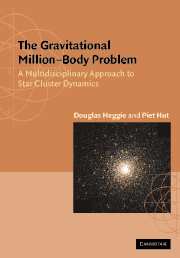Book contents
- Frontmatter
- Contents
- Preface
- PART I INTRODUCTIONS
- PART II THE CONTINUUM LIMIT: N → ∞
- PART III MEAN FIELD DYNAMICS: N = 106
- PART IV MICROPHYSICS: N = 2
- PART V GRAVOTHERMODYNAMICS: N = 106
- PART VI GRAVITATIONAL SCATTERING: N = 3
- PART VII PRIMORDIAL BINARIES: N = 4
- PART VIII POST-COLLAPSE EVOLUTION: N = 106
- 27 Surviving Core Collapse
- 28 Gravothermal Oscillations
- 29 Dissolution
- PART IX STAR CLUSTER ECOLOGY
- Appendix A A Simple N-Body Integrator
- Appendix B Hints to Solution of Problems
- References
- Index
28 - Gravothermal Oscillations
Published online by Cambridge University Press: 05 June 2012
- Frontmatter
- Contents
- Preface
- PART I INTRODUCTIONS
- PART II THE CONTINUUM LIMIT: N → ∞
- PART III MEAN FIELD DYNAMICS: N = 106
- PART IV MICROPHYSICS: N = 2
- PART V GRAVOTHERMODYNAMICS: N = 106
- PART VI GRAVITATIONAL SCATTERING: N = 3
- PART VII PRIMORDIAL BINARIES: N = 4
- PART VIII POST-COLLAPSE EVOLUTION: N = 106
- 27 Surviving Core Collapse
- 28 Gravothermal Oscillations
- 29 Dissolution
- PART IX STAR CLUSTER ECOLOGY
- Appendix A A Simple N-Body Integrator
- Appendix B Hints to Solution of Problems
- References
- Index
Summary
In the last chapter we saw that core collapse ends in what is (by stellar dynamics standards) a blaze of energy, which is emitted in interactions involving primordial binaries. Dramatic though that sounds, the real climax of the whole book is reached in the present chapter, where for the first time we catch a glimpse of the entire lifespan of a cluster. Admittedly we concentrate here on a highly idealised cluster, isolated from the rest of the Universe, consisting of stars of equal mass, and totally devoid of primordial binaries. In the next chapter we shall relax some of these idealisations.
Steady post-collapse expansion
What happens to the energy generated at the close of core collapse? To answer this question it is easiest to think of the cluster as a conducting, self-gravitating mass of gas, with its temperature decreasing from the core to the tenuous boundary. Because of the assumed temperature gradient, the heat flux is outwards, and the time scale for the transport of thermal energy is of order the local relaxation time, tr. Therefore, after an interval of order trh, i.e. the value of tr at the radius rh which contains half the mass, the thermal energy generated at core bounce has diffused throughout the bulk of the cluster. In the same time interval M, the mass of the cluster, has hardly altered (cf. Problem 16.1).
- Type
- Chapter
- Information
- The Gravitational Million–Body ProblemA Multidisciplinary Approach to Star Cluster Dynamics, pp. 263 - 271Publisher: Cambridge University PressPrint publication year: 2003

